 Homo floresiensis, also known as “the hobbit”, is probably the most famous hominin of the 21st century. Even my barber had heard of it. This popularity seems to stem from how strange the creature is, ensuring it is very popular with the media. Measuring in at just over a meter tall it’s the smallest member of the genus Homo ever discovered, yet still produced stone tools, walked upright and did all those other “human” things. This peculiarity isn’t just a media invention, Homo floresiensis was a genuinely revolutionary discovery. The unique stature broadened our understanding of anatomical variety within Homo, the fact they made complicated tools yet had small brains challenged the simplistic link between brain size and intelligence and their presence on an island hints at maritime technology hundreds of thousands of years before it was previously believed to have been invented.
Homo floresiensis, also known as “the hobbit”, is probably the most famous hominin of the 21st century. Even my barber had heard of it. This popularity seems to stem from how strange the creature is, ensuring it is very popular with the media. Measuring in at just over a meter tall it’s the smallest member of the genus Homo ever discovered, yet still produced stone tools, walked upright and did all those other “human” things. This peculiarity isn’t just a media invention, Homo floresiensis was a genuinely revolutionary discovery. The unique stature broadened our understanding of anatomical variety within Homo, the fact they made complicated tools yet had small brains challenged the simplistic link between brain size and intelligence and their presence on an island hints at maritime technology hundreds of thousands of years before it was previously believed to have been invented.
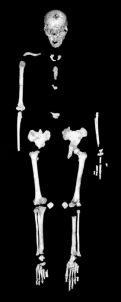
The skeleton of the hobbit
As with all revolutionary discoveries the hobbit has had its share of skeptics. Most notably some researchers suggested it was simply a modern human suffering from cretinism, dwarfism or other such pathological condition. Subsequent analysis revealed that Homo floresiensis had few of the traits associated with those conditions – aside from its small stature – confirming that it is a distinct, diminutive species of hominin (something you should know if you’ve been paying attention to me). However, this debate has been obscuring a much more interesting controversy: who was Homo floresiensis ancestor?
A common view of the hobbit claims it is a descendant of Homo erectus; as that was the first member of our family to migrate into Asia. They used their modern traits, such as long legs, short arms, big brains and much more (although they’re much not fully modern, still having a) to dominate the continent some time between 1.7 and 1 million years ago. Eventually a group of these creatures wound up on the Indonesian island of Flores, where island dwarfism decreased their size until they had become the diminuitive Homo floresiensis. However, the hobbit still has some archaic attributes that hint at an earlier ancestor. As such the case is far from closed, leaving us with 4 possible ancestors of the hobbit: Australopiths, early Homo (such as Homo habilis), later Homo (such as Homo erectus) or modern Homo. So – in Jeremy Kyle-esque fashion – lets meet the potential fathers:
- Australopithecus appeareed ~4 million years ago and is the ancestor of Homo but has many more ape-like characteristics. They still spent a good chunk of time in the trees, although they were still bipedal (please don’t get me started on that again). As a result they retained many of the ape-like arboreal adaptations, such as longer arms with long curved fingers and a differently orientated shoulder blade (scapula). They’re also much smaller than later species, with small brains and a prognathic face.
- Early Homo appeared ~2.6 million years ago are a mix of Australopithecus and later Homo. They have comparatively shorter legs and longer arms that appear to retain the ape-like curved fingers. They also have somewhat smaller brains and a more prognathic face than later Homo, although they’re similar to later species in enough ways to justify placing them within that genus.
- Later Homo appear ~1.5/1 million years ago andare almost fully modern. They’re tall upright bipeds with long, powerful legs. They have short arms ending in dexterous hands with stubby fingers. Their brains are bigger, allowing advanced behavior and technology. However, they retain some more ancient traits like an Australopith style rib cage, slightly prognathic faces and comparatively small brains
- Modern humans have essentially developed by 500 thousand years ago and are basically later Homo but refined. With a flat face, even bigger brain and even longer, more powerful legs there’s nothing we can’t do!
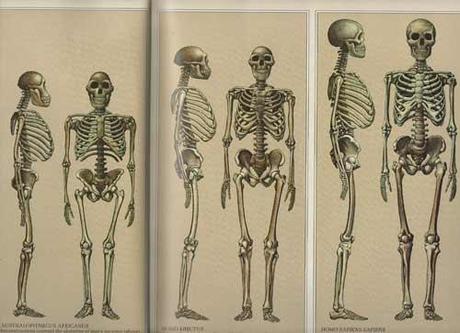
The candidates. Alas there are few good skeletal reconstructions of early Homo, so you’ll just have to imagine them.
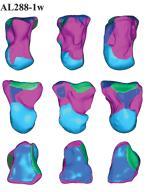
The wrist bones of Lucy (left), the hobbit (middle) and humans (right). Note how the hobbit is most similar to Lucy
Straight away we can rule out modern humans. Apes and humans engage in different activities with their wrist (tool manipulation versus climbing) and as a result the bones in the joint are different. Australopiths, who also spent a good chunk of climbing, retained the ape-like wrist joint (as do early Homo). Whilst it is not identical to the ape wrist – being in the process of evolving towards the modern wrist – it is still definitely distinct from more modern species. The earliest evidence for the modern wrist comes from a specimen ~800,000 years old . When researchers examined the wrist bones of Homo floresiensis back in 2007 they found that they were much more similar to the Australopith style wrist than the modern human one. As such this means that their last common ancestor with us lived before the derived wrist developed (i.e. it must be older than 800,000 years). Unfortunately we have few wrist bones from later Homo so we can’t rule them out as well.
We can, however, eliminate the Australopiths as an option. The only traits which link the hobbit and Australopithecus are the small brain, small height and long arms. For example, the famous Lucy specimen is almost exactly the same height as the hobbit. Yet all of these are traits also shared by early Homo (or could be explained by island dwarfism) so are hardly a convincing argument for an Australopith ancestor. Further, the hobbit has a comparatively flat face with a plethora of traits associated with Homo and uses stone tools – something no Australopithecine is known to do. When one does a statistical analysis Homo floresiensis almost never appears near a member of Australopithecus.
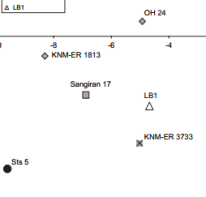
The triangle is the hobbit, squares are later Homo, diamonds are early Homo and the circle is Australopithecus.
This leaves us with later Homo, as the traditional model would have you think, and early Homo such as Homo habilis or maybe early Homo ergaster. If this is the case then it would mean the first hominin to leave Africa was much more primitive than previously though, revolutionising our understanding of human evolution. As such this is a topic of great interest which has prompted a good deal of research and a slurry of comparisons between the various candidates have been published. Unfortunately not much of it is able to arrive at a definitive answer, failing to show distinctive similarities with Homo habilis and Homo erectus.
So we know that it doesn’t really fit with either species but can we work out how they are related? Yet more researchers fed all the data from these other analyses into cladistics software which calculated the relationships between them all based on a variety of variables and mathematics I won’t even pretend to understand. The data gave two results, both of which indicated that the hobbit evolved from early Homo. The first suggests it arose between 1.86 and 1.66 million years ago, the second suggests it happened after 1.66 million years ago.
Although some have been critical of the methodology of this cladistic analaysis the results of alternative studies are markedly similar to this one. This replication lends credence to these conclusions, suggesting they are quite accurate. This means that is most likely a descendant of early Homo, indicating that a much more primitive hominin left Africa than previously thought. Some have even taken it to suggest that Homo didn’t appear in Africa at all! Perhaps more astoundingly than any revolutions that stem from this discovery is the fact that this archaic form managed to survive, isolated from the rest of the world until 12,000 years ago.
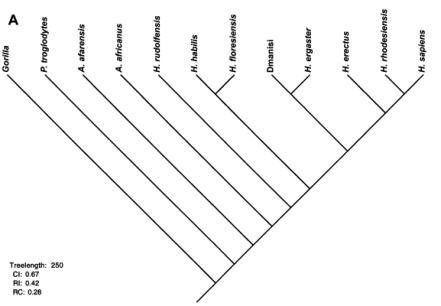
The family tree the cladistic analysis came up with.
Argue D, Morwood MJ, Sutikna T, Jatmiko, & Saptomo EW (2009). Homo floresiensis: a cladistic analysis. Journal of human evolution, 57 (5), 623-39 PMID: 19628252

